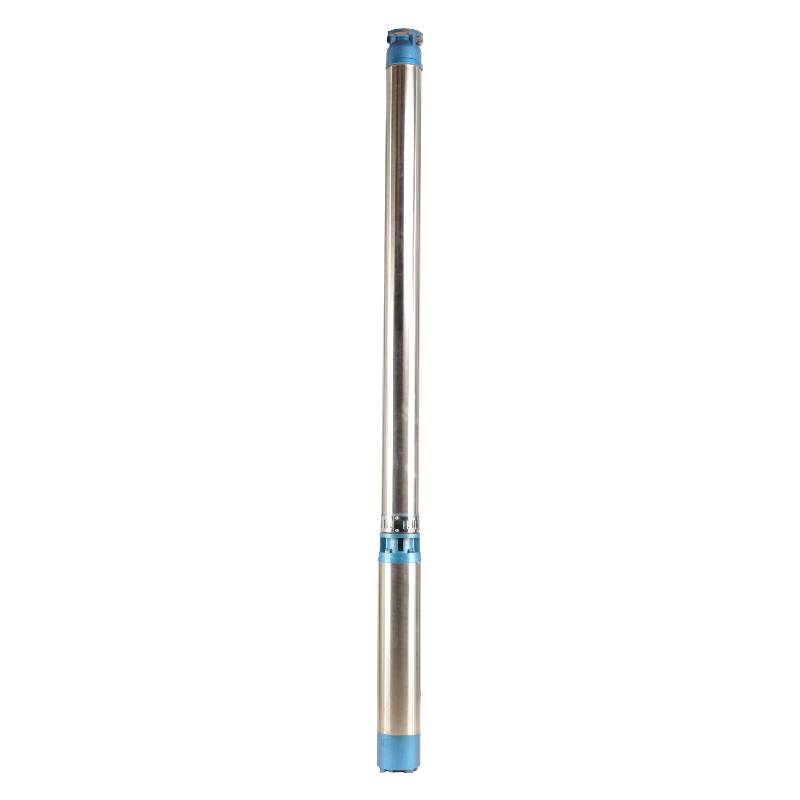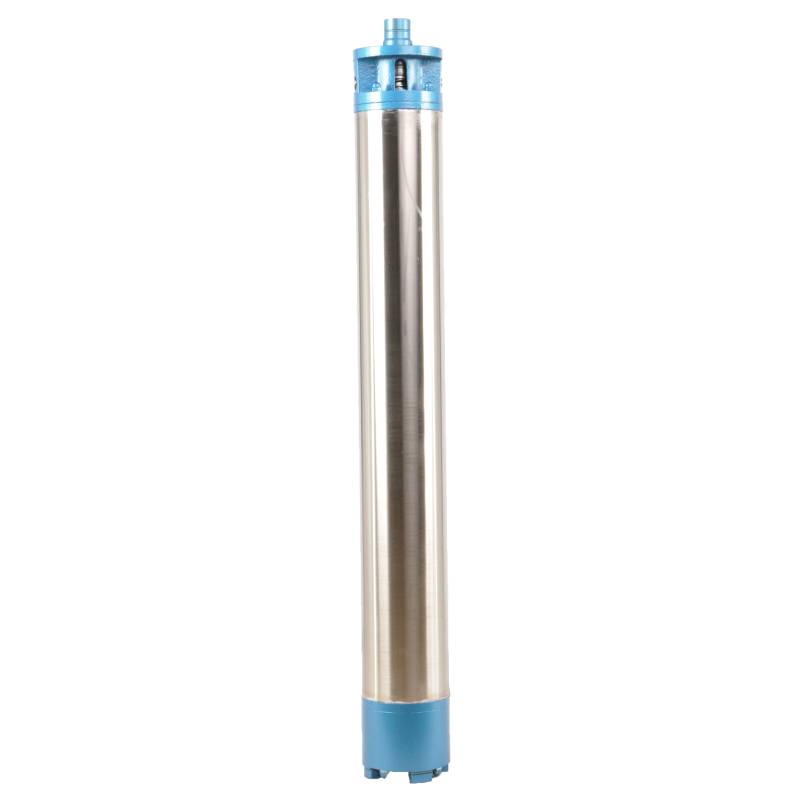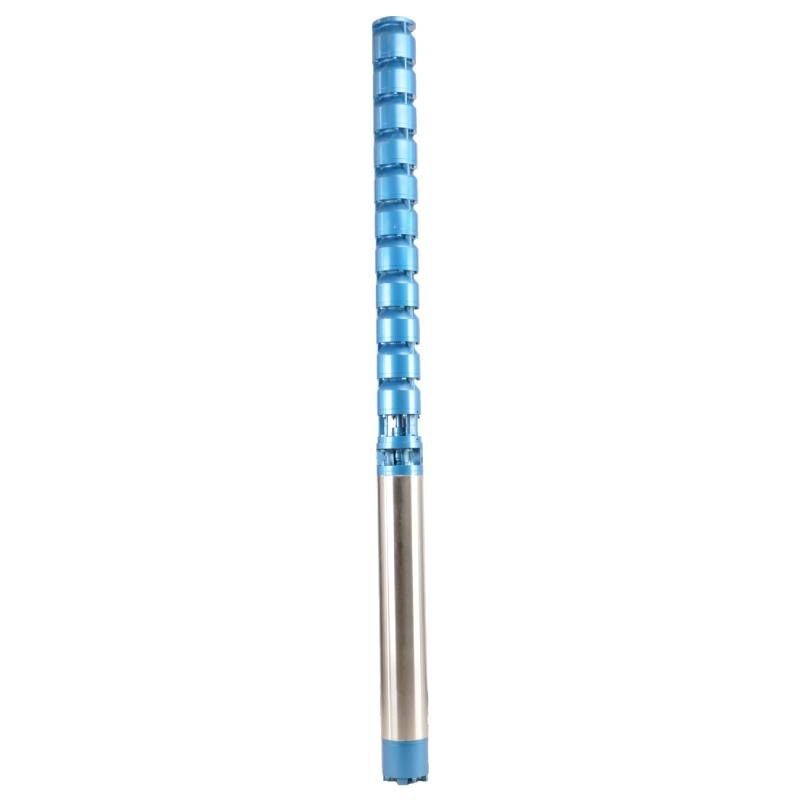QJ series submersible pump is a kind of lifting machine directly connected to the submersible motor and pump to work in the water. This series of pumps is vertical, small footprint, compact structure, simple installation, easy maintenance and repair. It is widely used in agricultural irrigation, municipal engineering, water conservancy projects, urban water supply and drainage and industrial and mining enterprises, drought relief and drainage, etc. The flow range is 5-500m3/h, the head is 4-800m, and the power is 3-315KW. This submersible pump can efficiently lift and transport water, providing reliable water supply for various fields. Its stable performance and solid structure make it an indispensable machine and equipment for various water conservancy projects.
The power supply of this product is three-phase AC 380V (tolerance ± 5%), 50HZ (tolerance ± 1%).
The water quality shall meet the following requirements:
(1) the water temperature shall not be higher than 20 °C;
(2) the content of solid impurities (mass ratio) shall not exceed 0.01%;
(3) the PH value (acidity and alkalinity) is 6.5-8.5;
(4) the content of hydrogen sulfide shall not exceed 1.5mg/L;
(5) the content of chloride ions shall not be higher than 400mg/L.
The motor is a closed or water-immersed wet structure. Before use, the inner cavity of the submersible motor shall be filled with water to prevent empty, and then the water injection and air exhaust bolts shall be tightened, otherwise it shall not be used. The submersible pump must be completely immersed in water to work, and the immersion depth shall not exceed 70 meters, and the distance between the bottom of the pump and the bottom of the well shall not be less than 3 meters. The well water inflow shall meet the water output and continuous operation requirements of the submersible pump, and the output water shall be controlled at 0.7-1.2 times of the rated flow. The well shall be vertical, and the submersible pump shall not be used horizontally or inclined, but only vertically. The submersible pump shall be equipped with cables as required, and equipped with external overload protection devices. It is strictly prohibited to conduct no-water no-load test on the pump.
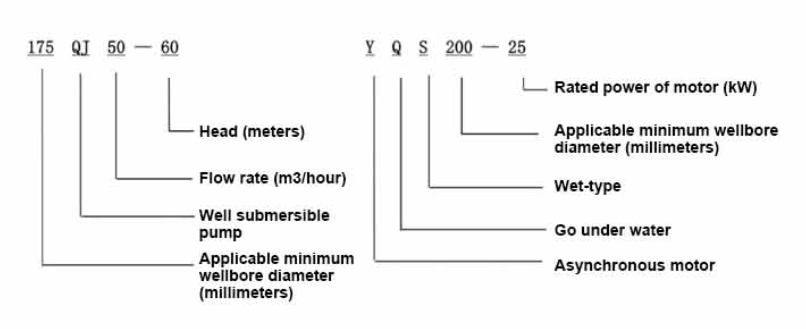
| Tauira | Rere (m3/h) | Upoko (m) |
Tere hurihuri (hurihia/tohu) |
Puma wai(%) | Putanga diameter (mm) |
E tika ana diameter(mm) |
Whakatauria mana(KW) |
Whakatauria ngaohiko(V) |
Whakatauria nāianei(A) |
Te Motika (%) | power factorcosφ | Waeine Rahi Morahi Radial(mm) |
Korero | |||||||||
| 135QJ5-34 | 5 | 34 | 2850 | 40 | 135runga | 1.5 | 380 | 4.23 | 128 | |||||||||||||
| 135QJ5-51 | 51 | 2.2 | 6.03 | |||||||||||||||||||
| 135QJ5-68 | 68 | 3 | 8.01 | |||||||||||||||||||
| 135QJ5-85 | 85 | 4 | 10.53 | |||||||||||||||||||
| 135QJ5-102 | 102 | 5.5 | 14.1 | |||||||||||||||||||
| 135QJ5-119 | 119 | 5.5 | 14.1 | |||||||||||||||||||
| 135QJ5-240 | 240 | 11 | 26.28 | |||||||||||||||||||
| 135QJ5-280 | 5 | 280 | 2850 | 40 | 135runga | 13 | 380 | 30.87 | 128 | |||||||||||||
| 135QJ5-320 | 320 | 15 | 35.62 | |||||||||||||||||||
| 135QJ10-24 | 10 | 24 | 2850 | 50 | 135runga | 1.5 | 380 | 4.23 | 128 | |||||||||||||
| 135QJ10-32 | 32 | 2.2 | 6.03 | |||||||||||||||||||
| 135QJ10-48 | 48 | 3 | 8.01 | |||||||||||||||||||
| 135QJ10-56 | 56 | 4 | 10.53 | |||||||||||||||||||
| 135QJ10-72 | 72 | 5.5 | 14.1 | |||||||||||||||||||
| 135QJ10-80 | 80 | 5.5 | 14.1 | |||||||||||||||||||
| 135QJ10-104 | 104 | 7.5 | 19.0 | |||||||||||||||||||
| 135QJ10-120 | 120 | 7.5 | 19.0 | |||||||||||||||||||
| 135QJ10-136 | 136 | 9.2 | 22.7 | |||||||||||||||||||
| 135QJ10-180 | 180 | 11 | 26.28 | |||||||||||||||||||
| 135QJ10-210 | 210 | 13 | 30.87 | |||||||||||||||||||
| 135QJ10-240 | 240 | 15 | 35.62 | |||||||||||||||||||
| 135QJ10-300 | 300 | 18.5 | 43.12 | |||||||||||||||||||
| 135QJ15-36 | 15 | 36 | 2850 | 50 | 135runga | 2.2 | 380 | 6.03 | 128 | |||||||||||||
| 135QJ15-39 | 39 | 3 | 8.01 | |||||||||||||||||||
| 135QJ15-46 | 46 | 4 | 10.53 | |||||||||||||||||||
| 135QJ15-52 | 52 | 4 | 10.53 | |||||||||||||||||||
| 135QJ15-59 | 59 | 5.5 | 14.1 | |||||||||||||||||||
| 135QJ15-65 | 65 | 5.5 | 14.1 | |||||||||||||||||||
| 135QJ15-78 | 78 | 7.5 | 19.0 | |||||||||||||||||||
| 135QJ15-91 | 91 | 7.5 | 19.0 | |||||||||||||||||||
| 135QJ15-104 | 104 | 9.2 | 22.7 | |||||||||||||||||||
| 135QJ15-120 | 120 | 11 | 26.28 | |||||||||||||||||||
| 135QJ15-142 | 142 | 13 | 30.87 | |||||||||||||||||||
| 135QJ15-162 | 162 | 15 | 35.62 | |||||||||||||||||||
| 135QJ15-200 | 200 | 18.5 | 43.12 | |||||||||||||||||||
| 135QJ20-16 | 20 | 16 | 2850 | 50 | 135above | 2.2 | 380 | 6.03 | 128 | |||||||||||||
| 135QJ20-24 | 24 | 3 | 8.01 | |||||||||||||||||||
| 135QJ20-32 | 32 | 4 | 10.53 | |||||||||||||||||||
| 135QJ20-40 | 40 | 4 | 10.53 | |||||||||||||||||||
| 135QJ20-48 | 48 | 5.5 | 14.1 | |||||||||||||||||||
| 135QJ20-56 | 56 | 5.5 | 14.1 | |||||||||||||||||||
| 135QJ20-64 | 64 | 7.5 | 19.0 | |||||||||||||||||||
| 135QJ20-72 | 72 | 7.5 | 19.0 | |||||||||||||||||||
| 135QJ20-80135QJ20-100 | 80 | 9.2 | 22.7 | |||||||||||||||||||
| 100 | 11 | 26.28 | ||||||||||||||||||||
| 135QJ20-120 | 120 | 13 | 30.87 | |||||||||||||||||||
| 135QJ20-136 | 136 | 15 | 35.62 | |||||||||||||||||||
| 135QJ20-168135QJ25-12 | 168 | 18.5 | 43.12 | |||||||||||||||||||
| 25 | 12 | 2850 | 65 | 135runga | 2.2 | 380 | 6.03 | 128 | ||||||||||||||
| 135QJ25-18 | 18 | 3 | 8.01 | |||||||||||||||||||
| 135QJ25-24 | 24 | 4 | 10.53 | |||||||||||||||||||
| 135QJ25-30 | 30 | 4 | 10.53 | |||||||||||||||||||
| 135QJ25-36 | 36 | 5.5 | 14.1 | |||||||||||||||||||
| 135QJ25-48 | 48 | 7.5 | 19.0 | |||||||||||||||||||
| 135QJ25-60 | 60 | 9.2 | 22.7 | |||||||||||||||||||
| 135QJ25-82 | 82 | 11 | 26.28 | |||||||||||||||||||
| 135QJ25-97 | 97 | 13 | 30.87 | |||||||||||||||||||
| 135QJ25-110 | 110 | 15 | 35.62 | |||||||||||||||||||
| 135QJ25-130 | 130 | 18.5 | 43.12 | |||||||||||||||||||
| 135QJ32-24 | 32 | 24 | 2850 | 80 | 135runga | 4 | 380 | 10.53 | 128 | |||||||||||||
| 135QJ32-30 | 30 | 5.5 | 14.1 | |||||||||||||||||||
| 135QJ32-42 | 42 | 7.5 | 19.0 | |||||||||||||||||||
| 135QJ32-54 | 54 | 9.2 | 22.7 | |||||||||||||||||||
| 135QJ32-68 | 68 | 11 | 26.28 | |||||||||||||||||||
| 135QJ32-80 | 80 | 13 | 30.87 | |||||||||||||||||||
| 135QJ32-92 | 92 | 15 | 35.62 | |||||||||||||||||||
| 135QJ32-104 | 104 | 18.5 | 43.12 | |||||||||||||||||||
| 135QJ40-46 | 40 | 46 | 2850 | 80 | 135runga | 11 | 380 | 26.28 | 128 | |||||||||||||
| 135QJ40-54 | 54 | 13 | 30.87 | |||||||||||||||||||
| 135QJ40-62 | 62 | 15 | 35.62 | |||||||||||||||||||
| 135QJ40-84 | 84 | 18.5 | 43.12 | |||||||||||||||||||
1, he papu ruku mo te papu wai ma, ka aukati i te puna hou, te pupuhi parataiao me te wai paru,
2, puna wai papu ngaohiko kōeke 380/50HZ, te whakamahi o te tahi atu māka ngaohiko o motors submersible Me ki te whakarite. Ko te taura o raro me whakamahi i te taura parewai, me whakauru ki nga taputapu tiimata, penei i te pouaka tohatoha, kaore i te tiimata me whai mahi whakamarumaru matawhānui motika, penei i te whakamarumaru o te ara iahiko poto, te whakamaru i te waahanga, te whakamarumaru i raro i te ngaohiko, te tiaki whenua, te whakamarumaru mangere. , i roto i te take o ngā āhuatanga rerekē, kia te pūrere tiaki he haerenga mahi wā.
3, ko te whakaurunga me te whakamahi i te papu me noho pono, ka aukati i te pana me te kume te pana ka makuku nga ringa me nga waewae, me tapahi te mana hiko i mua i te whakaurunga me te tiaki i te papu, te waahi whakamahi papu ki te whakatu " ki te aukati i te ru hiko" nga tohu maamaa:
4, ki raro i te puna i mua i te tāutanga ranei, me whakakiia te kōhao motopaika ki te wai māturu ranei kore-waikura ma matao kohua te wai, whakakikī te / tutaki wai, te papu i runga i te rere whakamātautau whenua, me ki te ruma papu wai whakahinuhinu rapa. urungi, timata tonu kaua e neke ake i te hekona, tirohia mena he rite te urungi ki te tohutohu urungi. I te wa e tika ana te papu, whakarongo ki te haumaru, aukati i te pakaru o te whara.
5, kia rite tonu ki nga tikanga o te ara o te papu, te awhe rere o te whakamahi, ki te aukati i te iti o te rere, te teitei ranei o te kaha o te kumara, te peera me etahi atu waahanga o te kakahu, ka wera te motuka motuka.
6, after the pump down the well, the measurement of the motor to the ground insulation resistance should not be less than 100M, after the start to observe the voltage and current, check the motor winding insulation, whether in line with the requirements; pump storage location temperature if less than freezing point, should be dry the motor cavity water, prevent the motor cavity water ice damage caused by low temperature.
1.Structure brief: pump part is mainly composed of pump shaft, impeller, diversion shell, rubber bearing, check valve body (optional parts) and other components. The motor part is mainly composed of base, pressure regulating film, thrust bearing, thrust plate, lower guide bearing seat, stator, rotor, upper guide bearing seat, sand throwing ring, water inlet node, cable and other components
2.The main feature of this product is the use of water-cooled wet submersible three-phase asynchronous motor. The motor chamber is filled with water, used to cool the motor and lubricate the bearing. The voltage regulating film at the bottom is used to adjust the pressure difference caused by the temperature rise of the motor. In order to prevent the sand in the well water from entering the motor, two oil seals are installed on the top of the motor shaft extension end, and a sand throwing ring is installed to form a sand control structure. This design ensures the long-term reliability and stability of the motor, which is an ideal choice for pump users.
3. In order to prevent the pump shaft from running up when starting, the pump shaft and the motor shaft are connected by a coupling, and an upper thrust bearing is installed under the motor.
4.The lubrication of the motor and the pump bearing is water lubrication.
5.he motor stator winding is made of high quality submersible motor winding wire, with high insulation performance.
6. The pump is designed by computer CAD, with simple structure and good technical performance.

(1) Whakaritenga i mua i te whakaurunga:
1. Tirohia mehemea ka tutuki te papu ruku ki nga tikanga whakamahi me te whanuitanga kua tohua ki te pukapuka.
2. Ma te whakamahi i te obiect taumaha me te diameter e rite ana ki te teitei o te diameter o waho o te papu ruku, ine mehemea ka uru te inneldiameter o te poka wai ki te papu ruku, me te ine mena ka tutuki te hohonutanga o te puna ki nga whakaritenga whakaurunga.
3. Tirohia mehemea he ma te rua o te puna me te wai pokarekare ranei. Kaua rawa e whakamahia he papu hiko ruku ki te horoi i te paru welor papu me te wai kirikiri kia kore e pakaru wawe te papu hiko ruku.
4. Tirohia mehemea he pai te tuunga o te rawhi whakaurunga welhead me te kaha ki te tu ki te kounga o te waahanga katoa.
5. Tirohia mehemea kua oti te whakaurunga o nga waahanga papu ruku me te tika kia rite ki te hoahoa huinga i roto i te pukapuka Tangohia te mata tātari ka huri i te hononga kia kite mena ka huri ngawari.
6. Wewetehia te wiri wai ka whakakiia te kohao motopaika ki te wai ma, kaua e pirau (tohu. me whakakiia ki runga), katahi ka whakakaha i te kopa wai. I muri i nga haora 12 o te werohia o te wai, kaua e iti iho i te 150M Q te parenga whakamarumaru o te motini ka ine ki te tepu wiri 500V.
7. Cable joint, cut off a 120mm rubber sleeve from one end of the outgoing cable and the matching cable with an electrician's knifethen stagger the length of the three core wires in a stepped shape, peel off a 20mm copper core, scrape of the oxide layer on theoutside of the copper wire with a knife or sand cloth, and insert the two connected wire ends in palirs.After tying the layer tightly with fine copper wire, solder it thoroughly and firmly, and sand of any. burrs on the surface. Then, forthe three joints, use polyvester insulation tape to wrap them in a semi stacked manner for three lavers. Wrap the two ends of thewrapping layer tightywith nyion thread,and then use a semi stacked method to wrap the tape for three layers. Wrap the outellayer with high-pressure insulation tape for three layers. Finally, fold the threestrands together and repeatedly wrap them for fivelayers with high-pressure tape. Each layer must be tightly tied, and the interlayer joints must be tight and fimm to prevent water frompenetrating and damaging the insulation, After wrapping, soak in water at room temperature of 20 ’c for 12 hours, and measurethe insulation resistance with a shaking table, which should not be less than 100M Ω
Ko te hoahoa tukanga waea waea kua honoa e whai ake nei: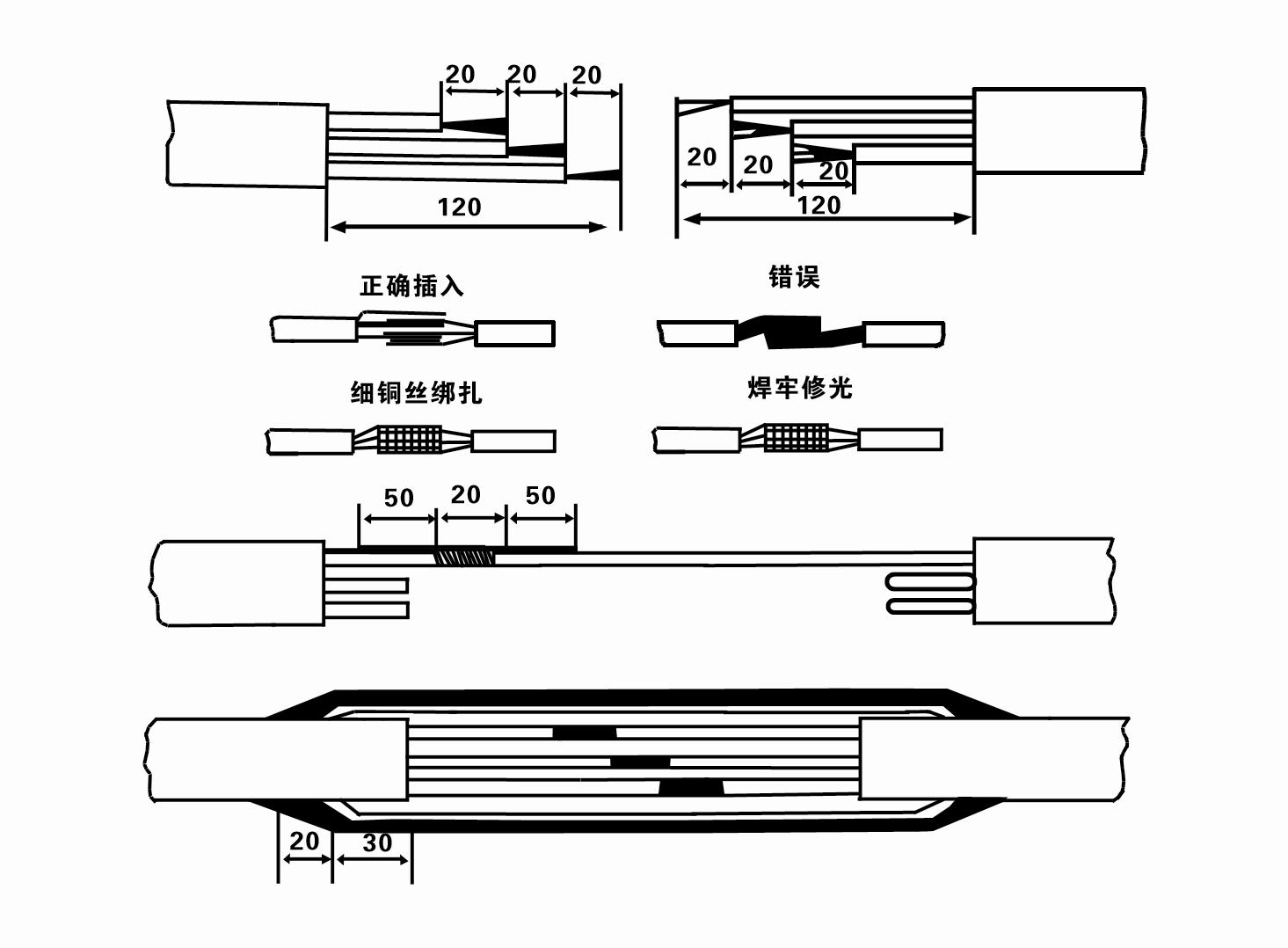
8. Whakamahi i te mita maha ki te tirotiro mena kei te hono nga waea-waa-toru me te ahua taurite te parenga DC.
9. Tirohia mehemea kua taumaha te ara iahiko me te kaha o te hurihanga, katahi ka hono atu i te pana whakamaru i te taumaha, i nga taputapu tiimata ranei. Tirohia te Ripanga 2 mo nga tauira motuhake, katahi ka ringihia he peere wai ki roto i te papu wai mai i te putanga papu wai hei whakahinuhinu i nga rapa rapa i roto i te papu, katahi ka tuu te papu hiko ruku ki runga kia mau. ka tirohia mehemea e rite ana te ahunga urungi ki te tohu urungi. Ki te kore, whakawhitia nga hononga e rua o te taura e toru-waahanga. Katahi ka whakauruhia te tātari ka takatu ki te heke ki raro i te puna. Mena ka whakamahia i roto i nga waahi motuhake (penei i nga awaawa, i nga awaawa, i nga awa, i nga harotoroto, i nga harotoroto, me etahi atu), me tika te turanga o te papu hiko.
(2) Nga taputapu me nga taputapu whakauru:
1. Kotahi te rua o nga mekameka hiki mo te neke atu i te rua tana.
2. He tripod me te teitei poutū kaua e iti iho i te wha mita.
3. E rua nga taura iri (wire ropes) ka taea te kawe i te taumaha neke atu i te kotahi tana (ka taea te kawe i te taumaha o te huinga katoa o nga papu wai).
4. Tāutahia kia rua ngā rawhi (splints).
5. Nga wrenches, hama, wiriwiri, taputapu hiko me nga taputapu, aha atu.
(3)Tautanga papu hiko:
1. Ko te hoahoa whakaurunga o te papu hiko ruku e whakaatuhia ana i te Whakaaturanga 2. Ko nga rahinga whakaurunga motuhake e whakaatuhia ana i te Ripanga 3 "Rarangi o nga Rarangi Whakamutunga o te Pump Hiko Rakau".
2. Ko nga papu hiko ruku me te upoko iti iho i te 30 mita ka taea te whakairi tika ki roto i te puna ma te whakamahi i nga ngongo me nga taura waea, etahi atu taura hemp ranei ka taea te kawe i te taumaha katoa o te miihini, nga paipa wai, me te wai i roto i nga paipa.
3. Ko nga papu me te upoko neke atu i te 30 mita te whakamahi paipa maitai, a ko te raupapa whakaurunga e whai ake nei:
①Whakamahia he rawhi hei rawhi i te pito o runga o te wahanga papu wai (kua honoa te motini me te papu wai i tenei wa), hikitia me te mekameka iri, ka ata herea ki roto i te puna tae noa ki te kuhua te rawhi ki te upoko o te puna ka tango mekameka iri.
② Whakamahia etahi atu rawhi hei rawhi i te paipa, hikitia me te mekameka iri kia 15 cm te tawhiti atu i te flange, ka ata whakaheke. I waenganui i te flange paipa me te flange papu Whakanohoia te papa rapa ki te waahi ka whakakoia te paipa me te papu kia rite ki nga tutaki, nati me nga horoi puna.
③ Whakaarahia te papu ruuma kia paku, tangohia te rawhi i te pito o runga o te papu wai, herea te taura ki te paipa wai me te riipene kirihou, ka ata herea ki raro kia tuu te rawhi ki te upoko puna.
④Whakamahia taua tikanga ki te here i nga paipa wai katoa ki roto i te puna.
⑤I muri i te hono o te taura arataki ki te pana whakahaere, ka hono atu ki te hiko hiko e toru nga wahanga.
(4) Nga mea hei tohu i te wa o te whakaurunga:
1. Mēnā ka kitea he āhuatanga tāmii i te wā e mahi ana te kumara, huri, kumea ranei te paipa wai kia pai ai te taunga. Ki te kore tonu e mahi nga momo mahi, tena koaKaua e tohe te papu ki raro kia kore ai e pakaru te papu hiko ruku me te puna.
2. I te wa o te whakaurunga, me whakanoho he papa rapa ki te taha o ia paipa me te whakakaha kia rite.
3. Ka tukuna te papu wai ki roto i te puna, me tuu ki waenganui o te paipa puna kia kore ai e rere te papu ki te pakitara o te puna mo te wa roa, ka wiri te papu, ka tahia, ka wera te motini. .
4. Whakatauhia te hohonutanga o te papu wai ki raro o te puna i runga i te rere o te onepu me te parapara o te puna. Kaua e tanu te papu ki te paru. Ko te tawhiti mai i te papu wai ki raro o te puna ko te tikanga kaua e iti iho i te 3 mita (tirohia te Whakaahua 2).
5. Ko te hohonutanga o te urunga wai o te papu wai kia kaua e iti iho i te 1-1.5 mita mai i te taumata wai hihiri ki te kohanga uru wai (tirohia te Whakaahua 2). Ki te kore, ka ngawari te pakaru o nga papa papu wai.
6. Ko te hiki o te papu wai e kore e iti rawa. Ki te kore, me whakauru he paera kuaha ki runga i te paipa wai o te upoko o te puna ki te whakahaere i te rere o te papu ki te waahi rere reiti kia kore ai te motini e nui te utaina me te wera na te nui o te rere.
7. I te wa e rere ana te papu wai, me noho tonu te whakaputanga wai me te ara, kia mau tonu te naianei (i raro i nga tikanga mahi kua whakatauhia, ko te tikanga kaua e neke atu i te 10% o te waa kua tohua), kaore he wiri, he haruru ranei. Mena he mate kino, me whakamutu te miihini kia kitea te take me te whakakore.
8. I te wa e whakauru ana, whakarongo ki te whakatakotoranga o te waea motika motika (tirohia te Whakaahua 2). Ina he paipa rino te paipa wai, arahina mai i te rawhi o te upoko puna; ina he paipa kirihou te paipa wai, arahina mai i te tohu whenua o te papu hiko.
- (1)After installing the submersible pump, it is necessary to recheck the insulation resistance and three-phase continuity of the switch, and check whether there are errors in the connection between the instrument and the starting equipment. If there is no problem, the test machine can be started. After starting, observe whether the indication readings of the instruments exceed the rated voltage and current specified on the nameplate, and observe whether the pump has noise and vibration. If everything is normal, it can be put into operation.
- (2)After the first operation of the pump for four hours, the motor should be shut down to test the thermal insulation resistance quickly, and its value should not be less than 0.5 megaohm.
- (3)After the pump is shut down, it should be started after five minutes to prevent the water column in the pipe from being completely reflowed and causing excessive motor current and burnout.
- (4)After the pump is put into normal operation, in order to prolong its service life, it is necessary to check whether the supply voltage, working current and insulation resistance are normal regularly. If the following conditions are found, the pump should be shut down immediately to troubleshoot.
1 In the rated condition, the current exceeds 20%.
2 Ka heke te taumata o te wai hihiri ki te wahanga uru wai, ka puta he wai mokowhiti.
3 He nui te wiri, te haruru ranei o te papu ruku.
4 He iti ake te ngaohiko tuku i te 340 volts.
5 Kua wera te ngongo.
6 Kua pakaru te paipa tuku wai.
7 The motor's thermal insulation resistance is lower than 0.5 megaohm.
- (5)Unit disassembly:
- 1 wetekina te taura taura, tangohia te wahanga paipa, tangohia te pereti waea.
2 whakawetohia te raka wai, kuhua te wai ki roto i te ruma motopaika.
3 tango i te tātari, wetewete te tīwiri pūmau i runga i te hononga ki te whakatika i te rakau nekeneke.
4 whakawetohia te raka e hono ana i te hononga whakaurunga me te motini, ka wehea te papu mai i te motini (kia tupato ki te urunga o te waeine ina wehe, kia kore ai e piko te pou papu)
5 ko te raupapa wetewete o te papu: (tirohia te ahua 1) te urunga whakaurunga, te impeller, te anga whakahuri, te impeller...... tirohia te tinana takirere, ina tango i te impeller, whakamahia nga taputapu motuhake hei wewete i te ringaringa koeko o te impeller mau. tuatahi, a karo i te piko me te maru o te rakau papu i roto i te mahi wetewete.
6 ko te mahi wetewete o te motini: (tirohia te ahua 1) tuu te motini ki runga i te papa, ka tango i nga nati, te turanga, te nati maukati mahunga, te pereti pana, te ki, te nohoanga kaiarahi o raro me te raka upoko rua mai i te raro o ka huri te motuka, katahi ka tango i te rotor (kia tupato kia kaua e pakaru te kete waea) ka mutu te tango i te waahanga hono me te nohoanga kaiarahi o runga.
7 unit assembly: before assembly, the rust and dirt of the parts should be cleaned, and the mating surface and fasteners should be coated with sealant, and then assembled in the opposite order of disassembly (the momentum of the motor shaft is about one millimeter after assembly), after assembly, the coupling should be flexible, and then the filter screen test machine. 6. The submersible pump is known for its durability and efficiency, providing you with a lasting pumping solution. When the operating time is more than one year per year, or if the operating time is less than one year, but the immersion time is up to two years, it must be disassembled and inspected in accordance with Article 5 to replace the worn parts. This pump is well designed to ensure efficient operation and reliability, so that you can rest assured. Whether it is used for pumping water from a family pond or pumping water for agricultural irrigation systems, this product can meet your needs. Choose this high-quality pump to keep your pump system in the best condition at all times, ensuring smooth operation and extending its service life.
1, whakawetohia te wai ki roto i te kohao motopaika (ina koa i te takurua kia kore ai te motini e makariri), kia pai te here i te taura.
2, store in an indoor room without corrosive substances and gases, with a temperature below 40 °C.
3, me aro te whakamahi mo te wa roa ki te aukati waikura o nga papu totohu.
- Kaipupuri
- Karekau kakau
- Karekau rakau rapa
-
mowhiti hiri
01 Te urunga wai hohonu
02 Te tuku wai teitei
03 wai maunga
04 wai pourewa
05 Te whakamakuku ahuwhenua
06 te whakamakuku maara
07 te urunga wai o te awa
08 wai whare

